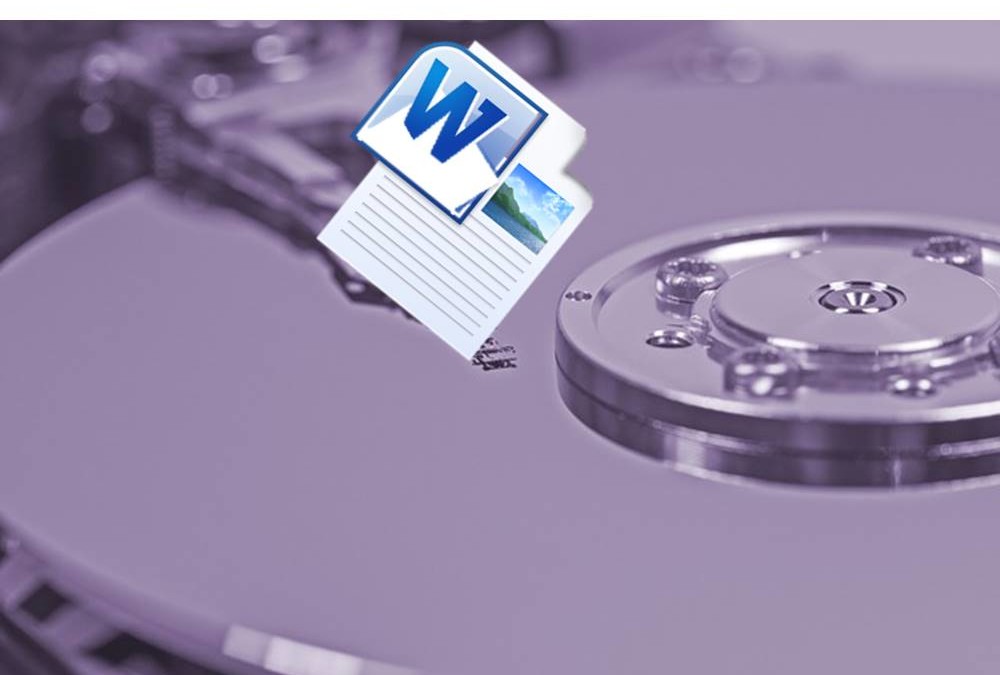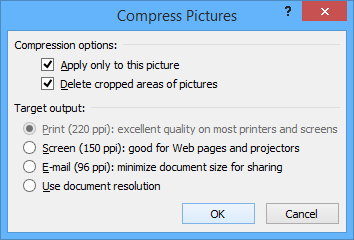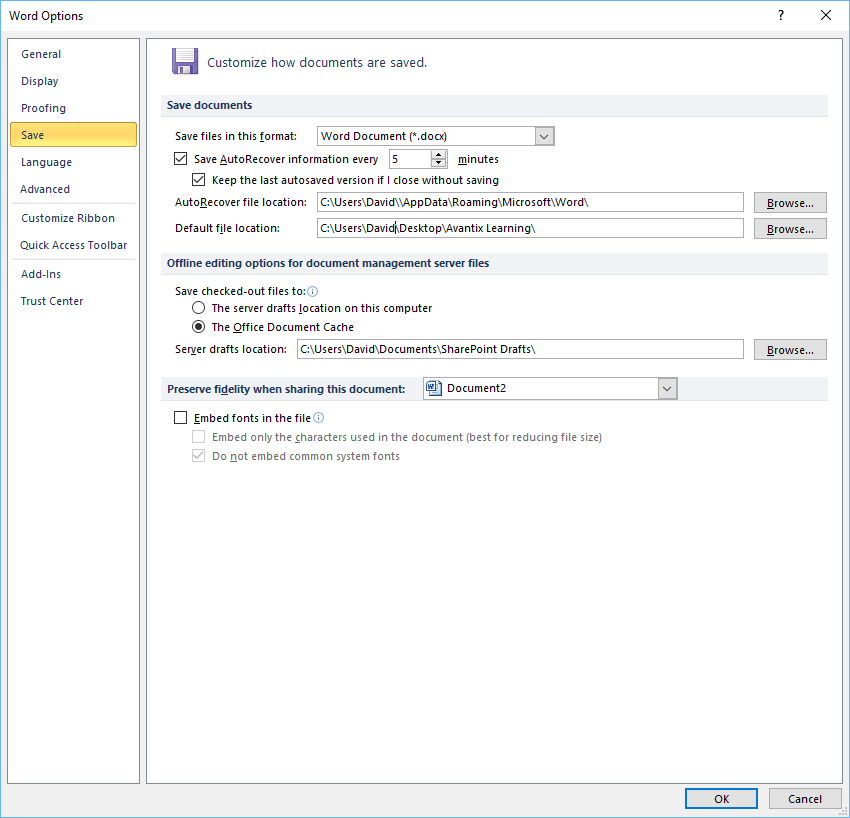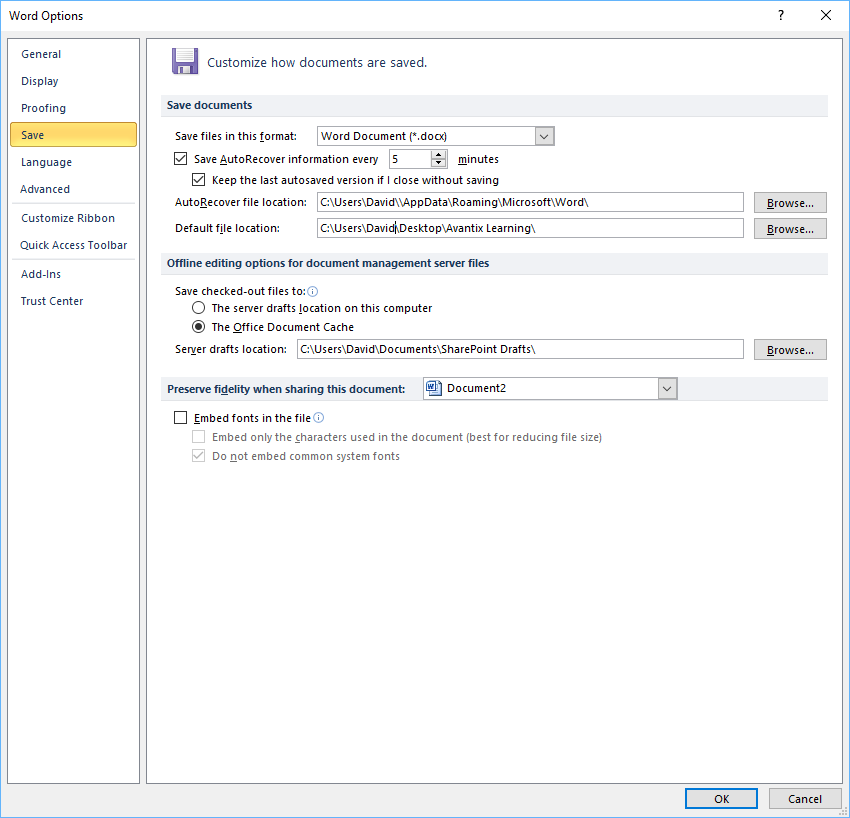Compress Microsoft Word File Size and Avoid Slowness, Corruption and Crashes
by Avantix Learning Team | Updated November 15, 2022
Applies to: Microsoft® Word ® 2010, 2013, 2016, 2019, 2021 and 365 (Windows)
You can reduce the size of a Microsoft Word document in several ways. The most common strategy to reduce Word file size is to compress pictures. However, you can also use other methods to deal with large documents such as saving media and Word files in other formats and limiting the use of specific features.
In this article, we'll look at 10 ways to reduce the size of a Word document:
- Compress pictures
- Insert pictures instead of copying and pasting
- Use smaller image files
- Apply styles instead of manual formatting
- Save a copy of large Word files
- Change Autorecover settings
- Avoid or convert embedded objects
- Avoid embedded fonts
- Save a copy of the document in PDF format
- Save a copy of the document in RTF format
Note: Buttons and Ribbon tabs may display in a different way (with or without text) depending on your version of Word, the size of your screen and your Control Panel settings. For Word 365 users, Ribbon tabs may appear with different names. For example, the Picture Tools Format tab may appear as Picture Format.
Recommended article: How to Hide Comments in Word (or Display Them)
Do you want to learn more about Microsoft Word? Check out our virtual classroom or live classroom Word courses >
To view file size of a Word document:
- Click the File tab in the Ribbon.
- Click Info. In the Properties area, file size is listed beside Size.
For some of the following strategies, you will need to close and save the file and then check file size again to see a difference in file size.
Compress pictures
Ideally, if you use small sizes when you insert pictures, this will reduce the size of your Word documents. However, you can compress one or all pictures in a Word file. You may wish to try this with one picture at a time to be sure you are satisfied with the result after compression.
To compress a picture or pictures:
- Click a picture.
- Click the Picture Tools Format or Picture Format tab in the Ribbon.
- Click Compress Pictures in the Adjust group. A dialog box appears.
- Select the option to apply only to the current picture or uncheck the option to apply to all pictures.
- Select the option to delete cropped areas of pictures if desired.
- Choose a document resolution.
- Click OK.
Insert pictures instead of copying and pasting
It's better to insert pictures using the Insert tab in the Ribbon, rather than copying and pasting from another file. When you copy and paste, the image can lose compression, change file type and also bring in other data that can increase file size.
To insert a picture in Microsoft Word:
- Click the Insert tab and click Picture(s). A dialog box appears.
- Navigate to the location of the picture.
- Click the picture and click Insert or double-click the picture.
You also have the option of linking to a picture file by clicking the arrow beside Insert in the Insert Picture dialog box and then choosing Link to File. However, the picture is not actually "in" the file (which reduces file size) so if you email the document, pictures will not be included.
Use smaller image files
It's best to insert pictures in smaller sizes to reduce the size of your Word files. For example, if you are inserting pictures from a phone taken at a high resolution, this will result in larger documents. Create, save or send images at a lower resolution and insert the lower resolution images into your documents.
If you're using stock images, select images at the lowest resolution (at the quality level you require). You can also open an image in an image editing program (such as Microsoft Picture Manager or Adobe Photoshop) and then save it at a lower resolution.
In Word 365, one of the biggest culprits causing inflated file size is 3D models. Although 3D models are not inserted as pictures but rather as 3D models, they are images. You can't compress 3D models like other types of images so you may need to delete 3D models or use a picture instead of a 3D model if file size is an issue.
Apply styles instead of manual formatting
The more manual or direct formatting you use in a Word document, the larger it will become. This becomes problematic with very large documents. Use styles as much as possible to reduce file size and automate formatting. Instead of applying 14 point, bold, and blue to a heading, consider using a style instead.
To apply a style:
- Select the content to which you wish to apply a style (such as a heading).
- Click a style in the styles group on the Home tab in the Ribbon.
To modify a style:
- Right-click the style in the Styles group on the Home tab in the Ribbon and choose Modify.
- Make the necessary changes.
- Click OK.
Save a copy of large Word documents
It's not a bad idea to save a copy of a large Word document periodically using Save As. If you save a copy using Save As, version history and some editing data is removed during the process.
To save a copy of a Word file:
- Click the File tab in the Ribbon.
- Choose Save As. If necessary, click Options or More Options. A dialog box appears.
- Navigate to the desired location and name the file with a different name (such as MarketingPlan2).
- Click Save.
Consider saving a copy of large files regularly and include a date in the name of the file (such as Marketing-Plan-May-7-2020). This can also help avoid corrupt documents.
Another recommendation is to use the Review tab in the Ribbon to accept or reject tracked changes and then turn off tracked changes. This can be done either before making the copy or in the copy. Extensive use of tracked changes can slow down a large document and increase file size.
Change AutoRecover settings
You can turn off AutoRecover entirely (not recommended) or change the time when Word creates an autorecover file. Word will no longer recover your Word files if you have a crash if you turn off AutoRecover completely so use this technique only if you are very comfortable with this setting.
To change the AutoRecover save time to a longer time (such as 20 minutes):
- Click the File tab in the Ribbon.
- Click Options.
- In the categories on the left, click Save.
- In the Save Autorecover information every 5 minutes, change the time.
- Click OK.
Save Autorecover options appear in the Word Options dialog box:
To turn off AutoRecover (not recommended):
- Click the File tab in the Ribbon.
- Click Options.
- In the categories on the left, click Save.
- Uncheck Save AutoRecover information every 5 minutes.
- Click OK.
On another note, if AutoRecover is turned on and you leave your Word file open when you leave your computer, the file continues to increase in size as Word creates new versions of the file. Consider closing the file when you're not working on it.
Avoid or convert embedded objects
If you embed objects (such as an Excel worksheet) in your Word documents, this will increase the size of your files. Try to avoid embedding if you need to reduce file size or convert embedded objects to pictures.
To convert an embedded object to a picture, select it and then press Ctrl + Shift + F9. To convert all embedded objects to pictures, press Ctrl + A to select all and then press Ctrl + Shift + F9. Some users may need to press Fn as well to enable their function keys. For more information about inserting Excel data into a Word document, check out 3 Ways to Copy Excel Data into Word.
Avoid embedded fonts
Another reason Word files may get very large is because of font embedding. Users may embed fonts if they are using a non-standard font and plan to open the file on a device that does not have the font installed. If using non-standard fonts, it's usually better to install the font on the other device rather than embedding (which can be buggy).
To turn off font embedding:
- Click the File tab in the Ribbon.
- Click Options.
- In the categories on the left, click Save.
- Ensure Embed fonts in this file is unchecked and click OK.
Embed fonts appears in Word Options in the Save category:
Save a copy of a document in PDF format
It's a common practice to save Word files in PDF (Portable Document Format) for portability and to reduce the size of the file. PDF documents can be shared with colleague when the Word file is too large.
To save a copy of a Word document in PDF format (and compress pictures):
- Click the File tab in the Ribbon.
- Choose Save As and then click Options or More Options if necessary. A dialog box appears.
- Navigate to the desired location and enter a name for the file. You can use the same name since the extension will be different (PDF).
- Under File Type, select PDF.
- Click Tools on the bottom right of the dialog box. A drop-down menu appears.
- Select Compress Pictures. A dialog box appears.
- Click the desired compression option.
- Click OK.
- Click Save.
Save a copy of a document in RTF format
Another technique you can try if a Word file seems to be too large or slow is to save the file as an RTF (Rich Text Format) file, reopen it and save it again in Word format.
To save a copy of a Word document as an RTF file:
- Click the File tab in the Ribbon.
- Choose Save As and then click Options or More Options if necessary. A dialog box appears.
- Select RTF as the file type.
- Navigate to the desired folder and enter a name.
- Click Save.
- Close the file.
- Click the File tab and choose Open.
- Double-click the RTF file.
- Click the File tab and choose Save As.
- Navigate to the desired folder.
- Select file type for Microsoft Word document (.docx).
- Enter a new file name.
- Click Save.
Other issues
Other features that may cause problems include a large number of drawing objects, inserting cross-references and grouping captions with images so you may want to avoid or limit the use of these features. It's also a good idea to save older files in .doc format to the new .docx format.
Subscribe to get more articles like this one
Did you find this article helpful? If you would like to receive new articles, JOIN our email list.
More resources
How to Double Space in Word (4 Ways + Shortcut)
How to Find and Replace in Word (and Use Wildcards)
How to Create a Hanging or First Line Indent in Word (3 Ways)
How to Insert an Em or En Dash in Word (4 Ways with Shortcuts)
How to Automatically Insert Reusable Text Snippets in Word Using Quick Parts
Related courses
Microsoft Word: Intermediate / Advanced
Microsoft Word: Designing Dynamic Word Documents Using Fields
Microsoft Word: Long Documents Master Class
Microsoft Word: Accessible Word Documents
Our instructor-led courses are delivered in virtual classroom format or at our downtown Toronto location at 18 King Street East, Suite 1400, Toronto, Ontario, Canada (some in-person classroom courses may also be delivered at an alternate downtown Toronto location). Contact us at info@avantixlearning.ca if you'd like to arrange custom instructor-led virtual classroom or onsite training on a date that's convenient for you.
Copyright 2024 Avantix® Learning
You may also like
How to Insert or Type I with an Accent Mark in Word (Í, í, Ì, ì, Î, î, Ï, or ï)
You can insert or type i with an accent mark in Word using built-in tools or keyboard shortcuts (including Alt code shortcuts). The letter i can be inserted with an accent in both upper or lower case. The following are common accented characters that you can insert or type in Word in upper or lower case: grave (Ì or ì), acute (Í or í), circumflex (Î or î) and umlaut (Ï or ï).
How to Insert or Type A with an Accent Mark in Word (À, Á, Â, Ä, à, á, â, or ä)
You can insert or type a with an accent mark in Word using built-in tools or keyboard shortcuts (including Alt code shortcuts). The letter a can be inserted with an accent in both upper or lower case. The following are common accented characters that you can insert or type in Word in upper or lower case: grave (À or à), acute (Á or á), circumflex (Â or â) and umlaut (Ä or ä).
10 Word Shortcuts to Select Text Using a Keyboard
You can use several shortcuts in Word to select text in your documents using only your keyboard. When you select text, it will typically be highlighted in grey. After you select text, you can cut, copy, or delete the selected text or apply character or paragraph formatting.
Microsoft, the Microsoft logo, Microsoft Office and related Microsoft applications and logos are registered trademarks of Microsoft Corporation in Canada, US and other countries. All other trademarks are the property of the registered owners.
Avantix Learning |18 King Street East, Suite 1400, Toronto, Ontario, Canada M5C 1C4 | Contact us at info@avantixlearning.ca










